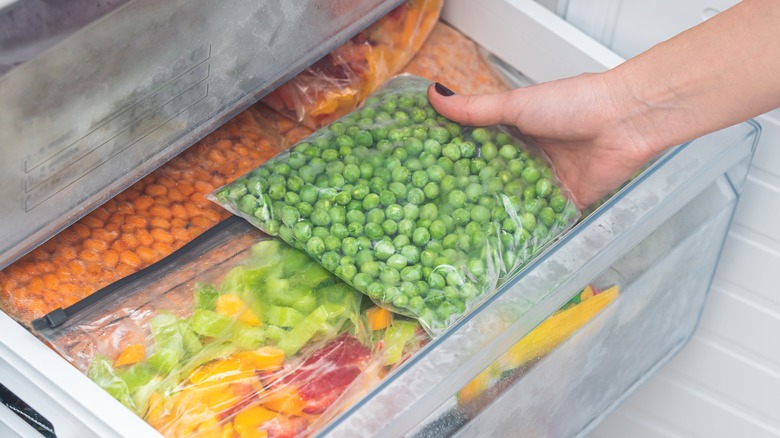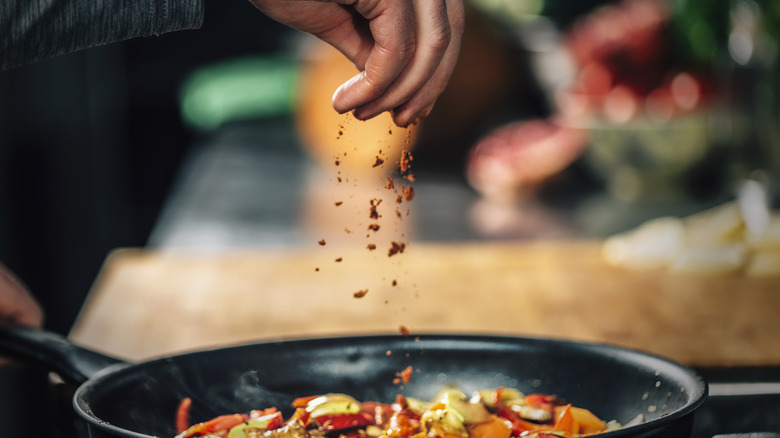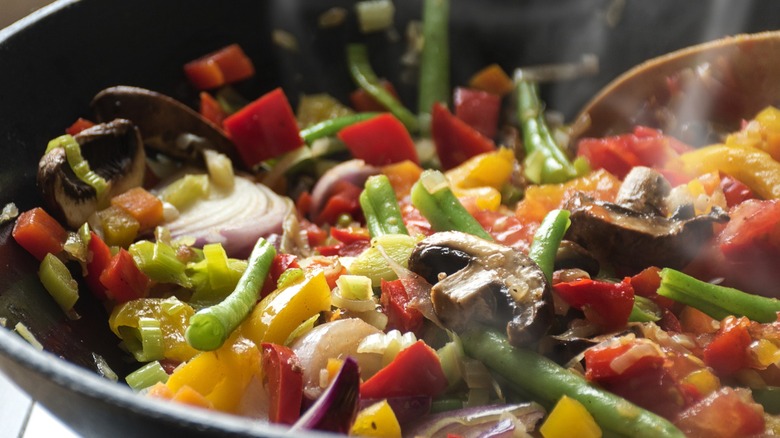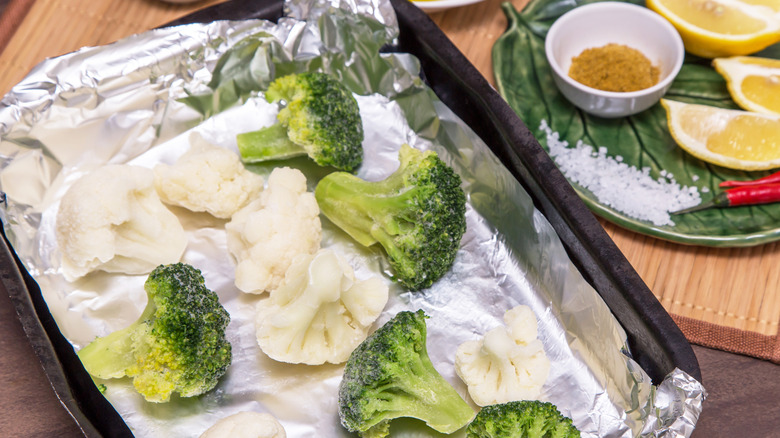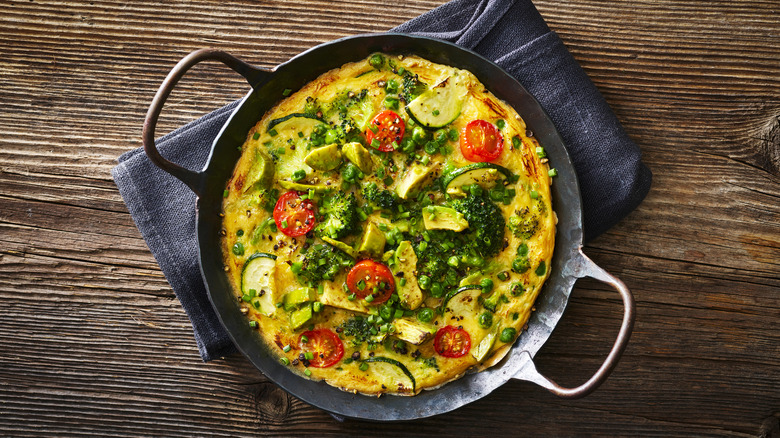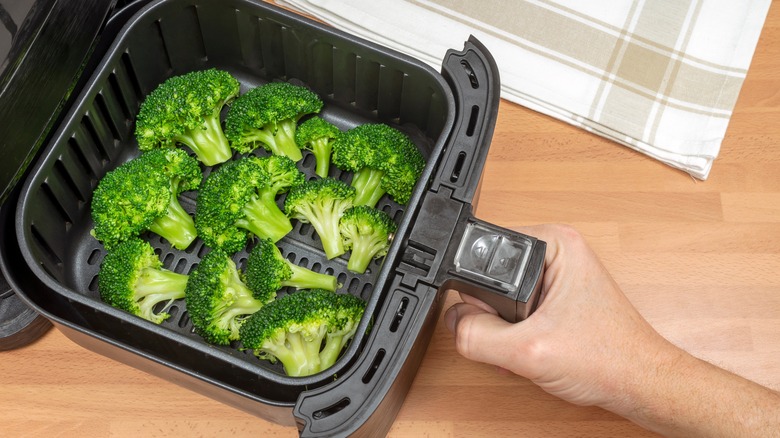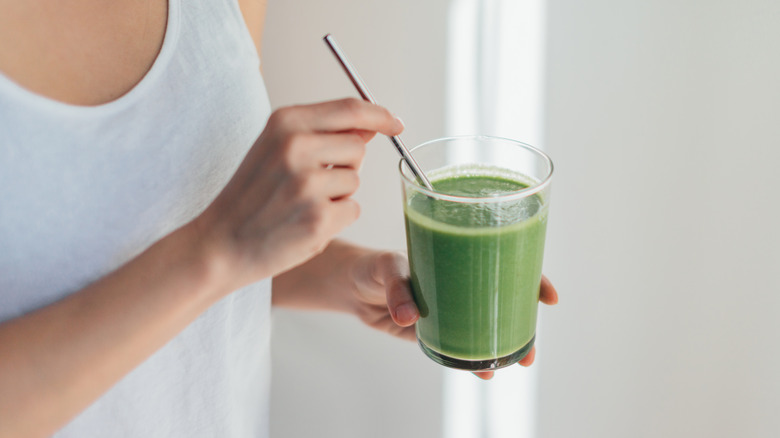7 Ways To Upgrade Your Frozen Vegetables
If you're looking for a quick alternative to fresh veggies, you may find yourself browsing the frozen food aisle but still hesitating to take the plunge. It's hard to compete with fresh produce, and if not prepared properly, frozen options can be seriously lacking in texture and taste. Fresh vegetables are not always available, can expire quickly, and often cost more, but thankfully there are a few tried and true methods for upgrading what you find in the frozen aisle. After speaking with Yasmeen Alsawwaf, a former food critic who is a trained chef and the culinary writer behind Yasmeen's Kitchen Diary, plus experimenting in my own kitchen, I've rounded up the best of the best tricks for mastering frozen vegetables.
Alsawwaf is a veteran in the food industry, and through personal experience she, like me, has come to the conclusion that frozen vegetables can often be just as delicious as the fresh options. However, success relies on using superior cooking methods, adding thoughtful seasoning, and avoiding bags that have thawed and been refrozen. "When vegetables thaw, their cell walls break down, causing them to lose their structure and release moisture," Alsawwaf says. This results in the dreaded mushy texture and a bland flavor. Instead, stick to these seven tips to upgrade your frozen vegetables.
1. Season your frozen vegetables with bold spices and sauces
Frozen vegetables often contain more water than fresh ones. And they are usually partially cooked before being frozen, which means it can be more difficult to coax out those natural flavors that occur when cooking raw vegetables. Therefore, it's especially important to carefully season with sauces and spices. Choosing particularly bold flavors can help elevate frozen vegetables to greater heights.
"The world of spices is vast and ready to be explored!" chef Yasmeen Alsawwaf says. Frozen vegetables present an opportunity to push boundaries in terms of taste, but the basics are also important to set the stage for a flavorful dish. "For a savory base, garlic and onion powder are wonderful. For a fragrant and earthy taste, thyme and rosemary work beautifully together," explains the practiced chef. For warmer flavors, Alsawwaf recommends cumin and coriander. "For heat and depth, chili flakes, paprika, garam masala, turmeric, and curry powder are wonderful," she says.
The truth is that adding flavor does not need to be a complicated guessing game. Personally, I love sautéing frozen green beans in Churn's Garlic and Shallot Butter for a rich, savory taste that is easy to create. Prepared spice mixes, such as Just Spices, or dips such as Cedar's Mediterranean Foods Garlic & Chive Feta Dip can take some of the guesswork out of seasoning. To add some heat for a simple side dish, consider tossing steamed broccoli in Tacodeli's queso or creamy jalapeño dip.
2. Prepare the vegetables by stir-frying
I often turn to stir-fries in my kitchen. They bring together bold flavors, create satisfying textures, and make a delicious meal even when you're short on ingredients. They also happen to be a fantastic option for preparing frozen vegetables. What is a stir-fry? The Chinese cooking method involves a large wok, some hot oil, and a bit of movement. The idea is to quickly cook ingredients over high heat in order to get a crunch on the outside. This translates perfectly when utilizing frozen green beans, broccoli, peas, peppers, carrots, and more, which are easy to overcook.
According to chef Yasmeen Alsawwaf, "Stir-frying frozen vegetables in a hot pan with some oil achieves a tender-crisp texture. This is due to the natural sugars in the vegetables caramelizing with direct contact of the pan and oil, achieving a Maillard reaction." Here, the temperature and the oil make all the difference. When cooking at home or in a professional environment, it's best to add flavor wherever you can. Even small details such as the type of oil you use can contribute. A few options to consider are High Heat Olive Oil by Fresh Press Farms, which makes stir-frying and adding that great earthy olive oil taste a simple task, or La Padella Oil by Corto, which is also specifically crafted for high-heat cooking.
3. Remove excess water while roasting your vegetables
It cannot be said too many times: Frozen vegetables typically have excess water that must be addressed to ensure success. This quality can often affect the texture and the flavor; therefore, whether you're roasting, sautéing, or air frying, you should consider a few tips to deal with the extra water. On top of that, there are other hacks, such as timing, that will give you the perfectly roasted veggies every time.
Let's talk about roasting frozen vegetables. I'm a fan of roasting veggies no matter the state of the ingredient because it's such an easy way to prepare a hearty meal, whether you're cooking for one or a big group. Simply toss your green beans, carrots, or potatoes in some olive oil, season them, dump them on a cookie sheet, and you're off to the races. As the vegetables cook, you'll usually notice a bit of extra water gathering in the pan. Set a timer for the halfway mark. When the vegetables have thawed and begun to cook, carefully remove the extra water from the pan and continue to roast them in the oven. The same principle applies when air frying and sautéing — anytime you notice excess water, toss it. You might be tempted to cook the water down, but this can lead to overcooking, which can ruin the texture.
4. Know the optimal cooking time for different vegetables and avoid overcooking
Cook time is always important when preparing something delicious. However, it tends to be more of an exact science when it comes to baking. Vegetables can be more forgiving and require less precision. That is true for fresh vegetables at least; however, there are other factors to consider when you're working with frozen options. "Frozen vegetables are partially cooked before freezing, so they need less cooking time than fresh ones," experienced chef Yasmeen Alsawwaf points out. "To prevent overcooking, add them later in the cooking process."
This might seem like a simple tip, but it can be easy to overlook this step in the heat of the kitchen. "When making a stir-fry, cook your proteins and aromatics first, then toss in the frozen vegetables during the last few minutes," Alsawwaf shares. Leafy greens, for example, will cook faster than root vegetables. They need only about two to three minutes in a hot pan, she says. Small and soft ingredients such as peas and corn require only about three to five minutes of cooking time. Alsawwaf points out that dense and firm vegetables, such as green beans or artichoke hearts, take about seven to 10 minutes to cook. Trial and error can help during this process, but it's more important to keep a close eye on your food and remember to check the texture while cooking to find the optimal results.
5. Try quick and easy recipes that make the most of frozen vegetables
A big part of the appeal of frozen vegetables is the simplicity. They cook faster and don't require the prep work such as washing, slicing, and dicing that fresh veggies do. Through various experiments in the kitchen, a few select recipes make the most of frozen vegetables. Vegetable stew comes to mind for chef Yasmeen Alsawwaf. "In a pot, sauté onions, garlic, and frozen vegetables like peas, carrots, and bell peppers with spices like turmeric, cumin, and cinnamon. Add vegetable broth and simmer until the vegetables are tender. Serve over couscous or rice," shares Alsawwaf. This is a quick, hearty option that doesn't set an expectation for too much crunch and doesn't suffer for it either.
Another no-brainer for using frozen broccoli, squash, spinach, and bell peppers is an easy vegetable frittata. Alsawwaf says, "Sauté frozen mixed vegetables in a skillet until thawed and heated through. Whisk eggs with salt, pepper, and a splash of milk, then pour over the vegetables. Cook until the eggs are set, then finish under the broiler if necessary." This is a warm and welcoming comfort dish that will turn heads at any breakfast or brunch for its flavor and its healthy ingredients. It's another forgiving recipe that can utilize a plethora of vegetables that you just might already have in your freezer.
For more ideas, see how one chef uses frozen vegetables to take meals to the next level.
6. Air frying on high heat is the best method
In my personal experience, cooking vegetables on high heat is an effective way to coax out subtle flavors and preserve the delicate and fickle texture of frozen options. An easy way to achieve this is to toss them in some oil and then into the air fryer. The high and dry heat will evenly cook the ingredients from all sides and avoid any unwanted sogginess.
Depending on the air fryer, you might need to stir the vegetables at the halfway point or at least flip them over. This is usually necessary if you're using a tray in an air fryer or convection oven rather than a basket with holes. The baskets allow the heat to reach all sides. However, using a basket means that excess water will drip, which can inadvertently result in steaming the veggies. Add a tray down below to avoid steam or consider pre-cooking the vegetables before utilizing the air fryer. For an expert level tip, air fry the vegetables, and then for the last minute use the broiler setting to add an extra layer of crunch.
For even better results, check out which frozen veggies made our list of the best and worst frozen foods to cook in your air fryer.
7. Use frozen veggies in dishes when the texture is not as important
Another trick when using frozen vegetables is to focus on specific recipes that will have a softer, less defined texture. And because not all frozen vegetables need to be cooked, Chef Yasmeen Alsawwaf shares her love of using frozen vegetables in smoothies. "Add frozen vegetables like spinach or kale to smoothies for an extra nutrient boost without altering the taste significantly," she says. This is an effortless way to boost your vegetable intake, and buying frozen greens limits the likelihood of them expiring in your fridge.
Another genius idea is to make muffins by subbing in frozen veggies for fresh ones. These carrot muffins or versions of this easy zucchini bread in muffin tins can be a quick and healthy snack that freezes perfectly or can be tossed into a lunchbox as part of a midday meal.
Finally, vegetable-packed sauces that are blended until smooth or pureed are another smart way to get the taste and nutrients from frozen vegetables. "Blend frozen vegetables into sauces like marinara or Alfredo for added nutrition and flavor," shares Alsawwaf. There are endless opportunities to get creative, and you'd be surprised by how many recipes will benefit from a few added frozen vegetables.
